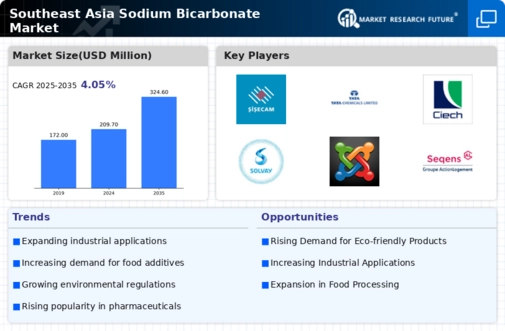Market Analysis
In-depth Analysis of Southeast Asia Sodium Bicarbonate Market Industry Landscape
The dynamics behind the sodium bicarbonate market in Southeast Asia are highly influenced by several factors that affect supply, demand, and prices. Some countries such as Indonesia, Malaysia, Thailand, and Vietnam, among others in Southeast Asia, have seen a considerable surge in demand for sodium bicarbonate used in various industries. For instance, the rising number of food processing entities has been one major driving force behind this trend. In addition, the pharmaceutical sector operating within South East Asia has played an important role in shaping trends concerning sodium bicarbonate. This explains why many pharmaceutical companies in the region are adopting sodium bicarbonate due to its versatile nature and its use in medical formulations and healthcare products to treat various illnesses, thereby enriching the dynamics of this market. It is further supported by the huge demand from patients suffering from different health diseases, which makes it a market that is constantly in motion. Environmental factors also play a significant role in influencing market dynamics. For example, Southeast Asia has recently experienced an increased emphasis on sustainability and eco-friendly operations across many countries. Some of the environmental remediation processes where baking soda, with its environmentally friendly characteristics, can be applied include air pollution control and wastewater treatment plants. On the supply side, availability and sourcing of raw materials have a great impact on market dynamics. Raw materials such as soda ash and carbon dioxide are needed in the production processes of sodium bicarbonate. These costs will influence overall production costs while determining the pricing strategy of sodium bicarbonate within this market, hence impacting the production price of sodium bicarbonate. Though other factors such as geopolitics, treaties, and fluctuations in exchange rates contribute to volatility within the chain of supply, hence affecting market dynamics. Furthermore, government regulations and policies greatly complicate the dynamics of the sodium bicarbonate market in Southeast Asia. There are regulatory frameworks on food safety, pharmaceuticals, and environmental compliance that may affect the production, supply chain, and usage of sodium bicarbonate. Furthermore, competitive forces among market players also contribute significantly to the market dynamics. The Southeast Asia sodium bicarbonate market is characterized by a mix of both domestic and international companies that are all fighting for a share in the market. For one to be able to remain above their counterparts in terms of competition, they need pricing strategies, product innovations, and distribution networks.











Leave a Comment